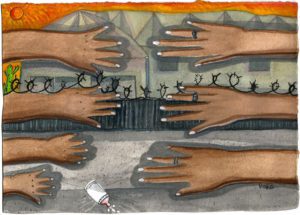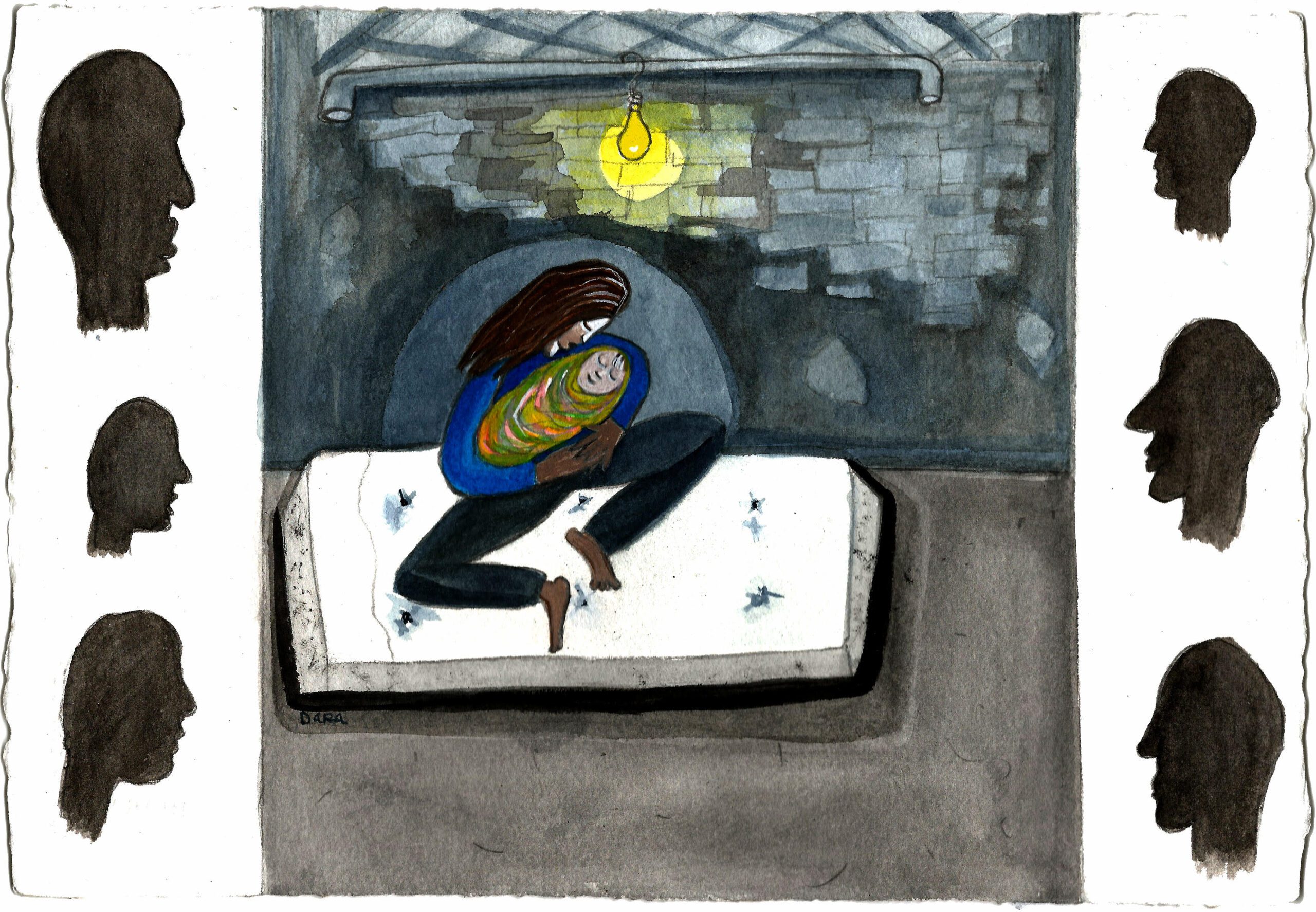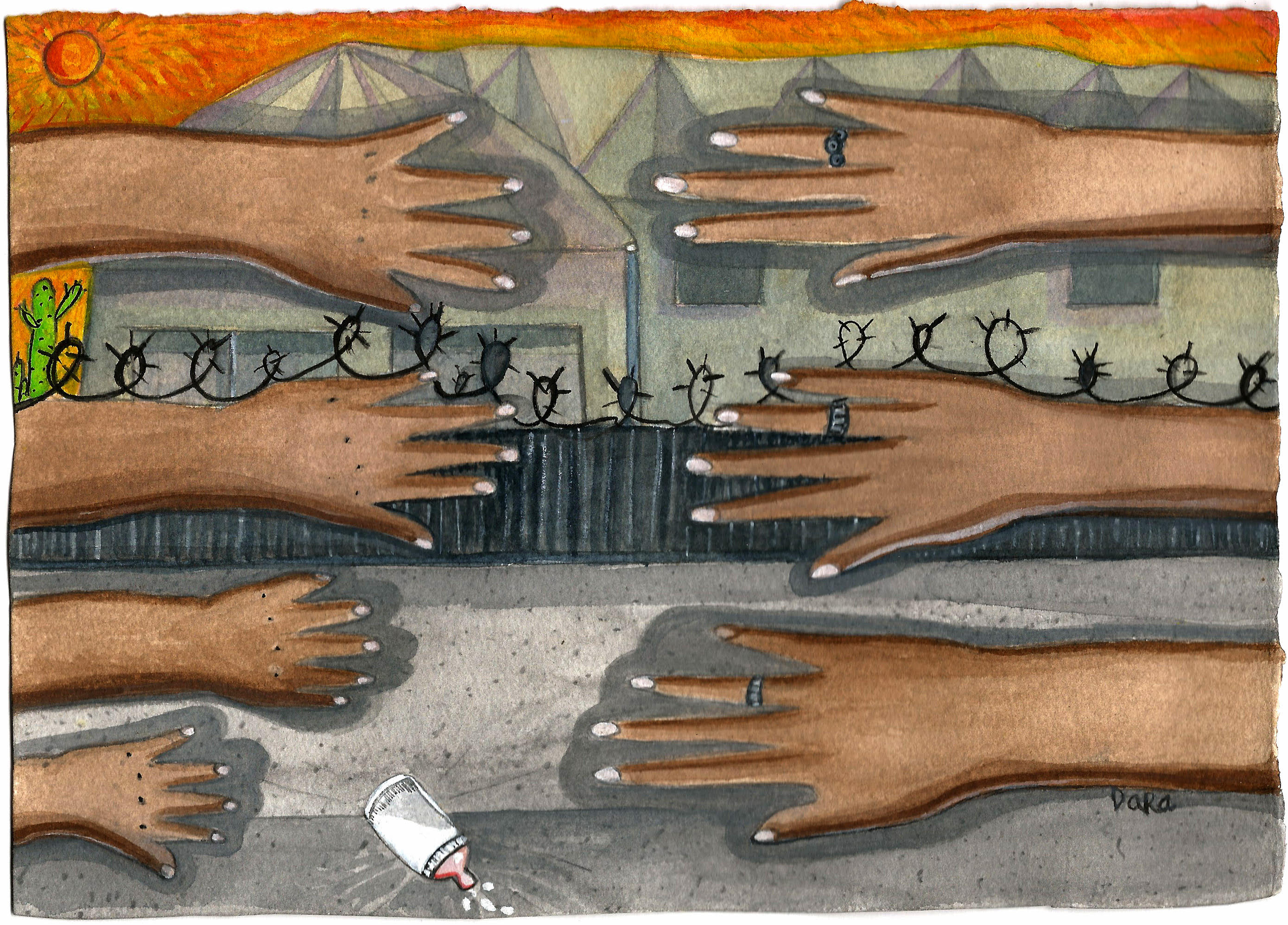
“We’re being invaded,” my Uber driver tells me as she signals, carefully watching the road ahead. “So many illegals,” she sighs. Sweat pools under the armpits of my dress suit, and I am either too hot under the Arizona sun or too concerned with maintaining my 4.8 star Uber rating to ask her why she thinks this. A brown man carrying two grocery bags, one in each hand, walks by us on the sidewalk. “See?” she says, motioning towards him. I don’t tell the driver this but she is driving me to a detention center that houses immigrant children outside of Phoenix, a place I volunteer as an auditing attorney. We are there to assess the conditions of the places we put children after we take them from their parents.
This center is the first of eight different detention centers and jails I will have visited after the Zero Tolerance Policy went into effect in April 2018, spurring the separation of thousands of children from their parents with no clear reunification plan. As a volunteer attorney, I audit and draft reports about facility conditions, and provide pro-bono consultations to immigration clients, mostly mothers and children, who have crossed the border seeking asylum protection in the United States. Many are fleeing domestic violence in countries that do not recognize domestic violence as a crime. As new policies roadblock the rights of asylum seekers, I have to explain that more and more, the law is being stacked against their formerly established right to protection in the United States.
Before volunteering as an immigration lawyer, I represented mostly women navigating San Francisco’s family law courts: domestic violence, divorce, and child custody cases. Helping mothers safeguard themselves and their children from husbands and fathers with records of past abuse was morally straightforward work. I liked seeing myself as a protector for those who didn’t have the resources to protect themselves. In family law, I got to play the person who was there to defend my mother from her father, a man who wore a big ring on the hand he used to hit her with while he pinned her down as a child. I got to play the person I wished I had when I was trapped in my own abusive relationship and didn’t know how to leave.
I met Dave when I was nineteen years old and fell in love with him immediately. It only took one month for me to move in with him, in a city far away from my home, where I knew no one except for him and his friends. I became addicted to the meth that he gave me and when he hit me the first time, I convinced myself I was too numb to feel it, and he was too numb to know what he had done. The first time he squeezed his fingers around my neck, the distinct, phantom sense of his fingernail lodged in my vein stayed. It reminded me of what he’d told me before I passed out: no one could love someone disgusting like me, that his love was a favor so great it required violence to maintain it.
For six months after my sister Beth helped me run away from him—after I tried to enlist the police to help get my Bible and clothes back from his house, after the police told me they couldn’t help—I’d duck, folding my body in half when I’d hear the whoosh of planes above. The sound is strikingly similar to the sound of a golf club being thrown at one’s head, the way Dave often threw his 7-iron at mine when we played Simi Valley’s Sinaloa nine hole community course after sleepless nights. Leaving him once I’d gone to rehab and woken from the slumber of drugs was not easy, but it was straightforward. I had my family, a counselor, and the law on my side. Helping my family law clients leave their abusers has been similarly straightforward. In immigration law, where many of the clients I meet are women and children, escaping the violence of husbands, gangs, and state-coordinated genocide is not so straightforward.
When an immigration nonprofit asks me to represent a man with two charges of domestic violence on his record, I hesitate. When I talk to his wife, she says she needs him more than she doesn’t want him. She is suffering from a vaginal infection after giving birth to their three-week-old baby, right before her husband was pulled over and arrested for not having papers. She lives in her husband’s boss’s basement, and can’t afford medical treatment until her husband gets out of jail and starts working. She needs him to not be deported, to work, even if that means he will sometimes hit her. I understand that when he hits her again someday, it may be because I helped him get out of jail. For her, the alternative is a return to a country where her family may be killed by members of a gang they disobeyed before they fled. I agree to take the case.
Instead of feeling angry at a system that leaves no good choices, I’m angry at the mother in the basement for not having more of them. I’m angry at my nineteen-year-old self for the times I was stuck between two bad choices: stay and get hit, or run and risk that Dave would find and kill me. When I finally did leave him, the law protected me in a way it doesn’t for non-citizens who must stay in their basements or risk deportation. The system does not protect or serve those we call “aliens.” The system plays with the fear of people it doesn’t consider human, openly threatening deportation, and actually deporting those who say anything, scaring people into staying quiet in the dark.
One week before Thanksgiving, I go to the largest detention center in the United States. It houses women and children. I, along with thirty other volunteer attorneys, prepare asylum seekers for their Credible Fear Interviews (CFIs). The CFI is one of the first steps in the immigration process after asylum seekers cross the border. The interview requires the asylum seeker to tell the story of the trauma they have experienced in their home country. Immigration officers then decide whether they believe the asylum seeker’s story. If they do, the asylum seeker may be allowed to stay in the United States to pursue a claim, where statistics show they will have a less than ten percent chance of winning. Perhaps that in itself is monstrous. We give people worried about surviving a sliver of hope to hold onto, knowing that even if they pass their CFI, the system stacks even higher against them. Most will be deported to the places they fled.
One client tells me how she went to the local police in Guatemala after her husband woke her up with his penis in her asshole and a gun pointed at her head. The police told her she couldn’t file a claim unless she had a bruise on her face. Only dark bruises would have been enough. She was too afraid to go home and there was no other place in her country where non-face bruises would warrant government protection, so she got on a bus and fled to the United States. She doesn’t have evidence of her abuse, or paperwork showing she tried to seek her government’s assistance, so it will be easy for our system to tell her we can’t help. For decades, the United States’s asylum law provided protection to domestic violence survivors, but now I must tell her that, just like in Guatemala, she’ll need proof to get protection. Her story alone is not enough. The nonprofit I worked with has trained me not to cry, not to show emotion, but I put my hand on hers, feel the cold of her knuckles against the tips of my fingers and bite the inside of my cheek, a distraction.
I see my grandmother. A grandmother I know only through pictures and stories my mother has told me. A grandmother who died young and often wore big dark glasses to cover her bruises. Before me, she was not a grandmother but a young woman with four kids and few choices. As a child, my mom and I watched a movie on Lifetime about a woman who was beaten by her husband. As dramatic music swelled, the man hit the woman in the face for the first time. My mom jumped from the bed and paced in front of the TV as the movie continued. Her hands pumped in fists, white. Her teeth pressed together so hard her lips disappeared. I begged her to sit back down. “Let’s keep eating the ice cream or it will melt,” I pleaded, wanting her to not be mad, wondering where the anger came from. “Go to college, Amy. Don’t get stuck,” my mom told me, and I promised her I wouldn’t. But then later, with Dave, I did get stuck, and then thanks to my sister, I got unstuck. I want so badly to help this woman from Guatemala get unstuck, too. But the limits of immigration law prevent me.
Another client, a teenage girl from El Salvador I’ll call Sarah, sits with her mother and cries as she tells me how when she was twelve, a gang member told her she needed to be his girlfriend. It was not presented as a choice. For two years, Sarah’s mother hid her in their family’s basement where a single light bulb hung off of a string made of dental floss. The gang broke into her family’s house and put a gun to her father’s head. “You give me your daughter or we will take her,” three gang members wearing hoods told him. Her family couldn’t go to the police because in their city, the gang and police work together. That night, Sarah and her mother got on a bus, beginning their two-month journey to the United States.
I go to Sarah’s CFI interview with her and we walk across the grass separating the housing trailer from the trailer where the hearings are performed. She repeats the story about her fear to an immigration officer who speaks through a translator on the phone. The line is fuzzy sometimes and the translator must repeat herself, relaying the girl’s story over and over until the details start to sound mundane. “A gun?” the asylum officer asks. “YES, A GUN TO HER FATHER’S HEAD!,” the translator says, yelling it the third time, when the officer finally hears it clearly enough, then types the detail into her notes. I feel like a monster, too, when forty-five minutes into the interview, I am annoyed that Sarah is not crying more. Be more dramatic, I think, impatient. If she is dramatic about her pain, her claim will have a better chance. In these trailer courtrooms, there is an unspoken expectation that humans process pain and trauma in only one way.
That night back at the motel, I catch the tail end of Thelma and Louise on the motel room TV. The story is about two women on the run, one escaping domestic violence, the other trying to help her friend navigate an impossible system with no good choices. Just like the stories from so many of the women I talked to that day. Maybe we care about Thelma and Louise more because they are American and beautiful but even for them, the system’s indifference to their pain feels like they can only survive if they run from the law rather than receive its protection.
In their ice-blue convertible, the women interlace fingers, like Sarah and her mother held hands. Louise steps her high-heeled shoe on the gas, running away fast and furious the same way my mother ran to college, the same way my sister helped me run from Dave, the same way the women I meet get on buses. The polaroid flies back through the desert dust, the things we all left behind when we went on the run.
For my clients, these stories of spectacular bravery and the will to survive are locked away in detention centers with fluorescent lights that never turn off. They are hidden outside society in the middle of Texas, behind bars of jails in North Carolina, stopped at the border in Tijuana.
We consume Thelma’s and Louise’s pain only if given to us in traditional dick-flick style with big rigs ablaze. When the scene stops midway through their ride over a cliff’s edge to death, it is easier to believe that maybe, miraculously, they got to the other side. It hurts too much to acknowledge that we know they didn’t make it. We hold on to slivers of impossible hope.
***
Rumpus original art by Dara Herman Zierlein.






